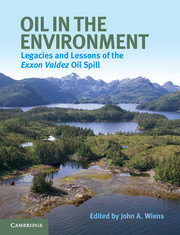Book contents
- Frontmatter
- Contents
- List of contributors
- Use of acronyms
- Acknowledgments
- A bibliographic note
- Prologue
- Part I Introduction and background
- Part II Oil in the environment
- 3 Oil in the water column
- 4 Surveying oil on the shoreline
- 5 Ancient sites and emergency response: cultural resource protection
- 6 Fate of oil on shorelines
- 7 Understanding subsurface contamination using conceptual and mathematical models
- 8 Removal of oil from shorelines: biodegradation and bioremediation
- Part III Biological effects
- Part IV Assessing oil spill effects and ecological recovery
- Part V Conclusions
- Index
- References
6 - Fate of oil on shorelines
Published online by Cambridge University Press: 05 July 2013
- Frontmatter
- Contents
- List of contributors
- Use of acronyms
- Acknowledgments
- A bibliographic note
- Prologue
- Part I Introduction and background
- Part II Oil in the environment
- 3 Oil in the water column
- 4 Surveying oil on the shoreline
- 5 Ancient sites and emergency response: cultural resource protection
- 6 Fate of oil on shorelines
- 7 Understanding subsurface contamination using conceptual and mathematical models
- 8 Removal of oil from shorelines: biodegradation and bioremediation
- Part III Biological effects
- Part IV Assessing oil spill effects and ecological recovery
- Part V Conclusions
- Index
- References
Summary
Introduction
Most oil tanker accidents occur near land. So when a marine oil spill occurs, it is usually not long before the spilled oil reaches shorelines. The shoreline is where the potential for harm to the environment and biological resources is the greatest, and where media attention and public concerns usually focus. Therefore, it is essential to determine the distribution, amount, composition, and fate of spilled oil on shorelines. This information forms the foundation for management decisions about cleanup during the early phases of the spill, assessments of long-term exposure and injury to biological resources, and long-term restoration strategies after the initial cleanup.
In this chapter, we consider the fate of shoreline oil following the Exxon Valdez oil spill, beginning with oil coming ashore in Prince William Sound (PWS) in 1989. This chapter picks up where Chapter 3 left off, describing where the oil was deposited, why some locations were oiled more than others, and how oil disappeared over time and why, in a few isolated locations, it persisted.
- Type
- Chapter
- Information
- Oil in the EnvironmentLegacies and Lessons of the Exxon Valdez Oil Spill, pp. 116 - 143Publisher: Cambridge University PressPrint publication year: 2013
References
- 4
- Cited by

